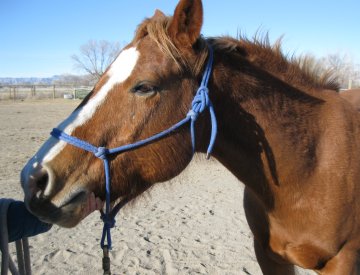
Very nervous with a tendency to bolt. Found to have bone spurs throughout his neck that caused intense pain in certain positions. This was his favorite neck stretch.
Horses are masterful at finding ways to move that diminish pain while maintaining the appearance of soundness. A horse can look gorgeous and healthy, be well cared for, and still be compensating for undiagnosed pain. In a predator rich environment this would be part of their survival strategy. In our domesticated world, they work through pain because we ask them to. They will continue to compensate and work for us until something gives.
When something gives it might show up as a clinically diagnosable lameness. Our horse starts visibly limping, for example. It might show up as illness – recurring ulcers or metabolic syndrome can be caused by the stress of chronic pain. But, before lameness and illness there are often early warning signs that show up in the form of changes in behavior.
Some horses hide their discomfort so well that you might not think anything of it. The behaviors are easy to dismiss as something to be trained through. Common training issues can be an early warning sign of a physical issue: refusal to pick up the right lead in canter, difficulty transitioning from one gait to another, trouble standing still at the mounting block, or refusals to turn in one direction or the other, to name just a few. Some behaviors are easy to misinterpret, like the horse that bit at his chest and acted like he was itchy, when in reality he hurt all over.
This horse refused to pick up the right lead canter, would rear, or buck when asked. She charged and struck at people on the ground when asked to canter in a round pen. And she was extremely head shy. She was given a clean bill of health and passed a pre-purchase exam. Ultimately diagnosed: calcification in nuchal ligament near poll, mild navicular changes in one front, damage in right stifle, and a host of other small things that all added up to a lot of discomfort. Same horse on right after some therapeutic work and now, years later, she’s comfortably sound and ridden with understanding for her issues.
Every time I encounter a horse that is behaving ‘badly’, having trouble doing something that from a training perspective should be pretty straight forward, I ask the same question. Are you sure he/she is not in pain? The people that come to me care immensely about their horses. They have done their due diligence. Teeth have been checked, feet are well cared for, nutrition dialed in, tack meticulously fit. They have tried every solution available to them to no avail. Veterinarians and an array of alternative practitioners have weighed in to give the horse a clean bill of health.
These people show up on my doorstep because they still feel like something isn’t right. They know their horse is behaving ‘badly’, or struggling to perform what should be easy tasks, for a reason. They don’t want to ‘train’ through it, they want to know why their horse is struggling. Without fail, every time I encounter one of these horses, I find they are indeed in pain. This an alarming trend, the number of horses I see at clinics who are struggling because they have unrecognized physical issues that cause anything from nagging discomfort, to balance issues, to pain so intense they lash out.
So why is it that competent, well trained professionals are missing something that both the horse’s owner and myself can plainly see, feel, and work with?
I have a theory that we can trace the reason back to that instinctive drive to appear sound as a survival strategy. Any training methods, any palpation techniques, bodywork, or methods of evaluating for lameness that involve obedience, or cause the horse stress could trigger the release of chemicals that put the horse in fight or flight mode, flooding their nervous system with adrenaline and effectively masking pain to the degree sub-clinical lameness won’t be visible. I believe the reason we, as a horse’s primary care-giver might still think something is wrong is because there is a bond of trust that isn’t always there with others that come in to evaluate. Our horses show us things in those moments of trust that would otherwise remain invisible.
From my perspective the most humane and compassionate thing we can do is assume a behavior problem is valid rather than naughty, lazy or bad, and work our butts off to find the source of the horse’s physical, mental or emotional discomfort. Then we can focus our efforts toward movement practices that support the weak area to promote comfort, and ultimately soundness. If you feel your horse has an issue trust your gut and keep seeking answers until you find them. No one knows your horse better than you. And your horse likely doesn’t trust anyone else more than you!
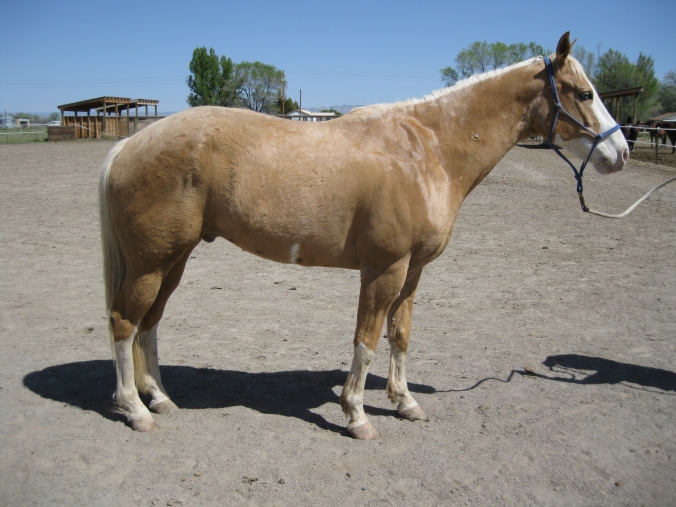
Constantly trying to bite people. He was overtly lame but had gone untreated for so long he could hardly stand to be touched and was very angry.
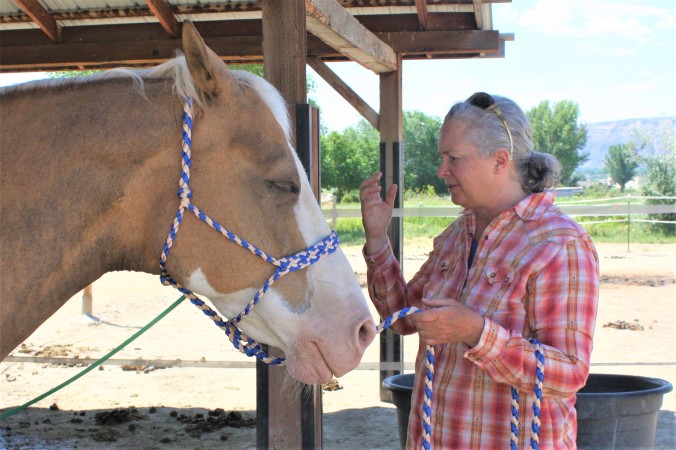
During an osteopathy treatment where it was found he had internal adhesions that prevented him from standing straight behind. I can’t imagine how much that hurt.
Remember, horses are masters at not limping. A limping horse is predator bait. If a training method causes stress it’s releasing chemicals that help them mask pain. If the vet exam or body work causes pain in the course of diagnostics it’s releasing those same chemicals. Bottom line, if your horse is stressed it’s that much harder to pinpoint subtle sources of pain or discomfort. Your horse is far more likely to show you what’s bothering them than a total stranger because they know you are looking and they trust you. Don’t let him down. Keep seeking!
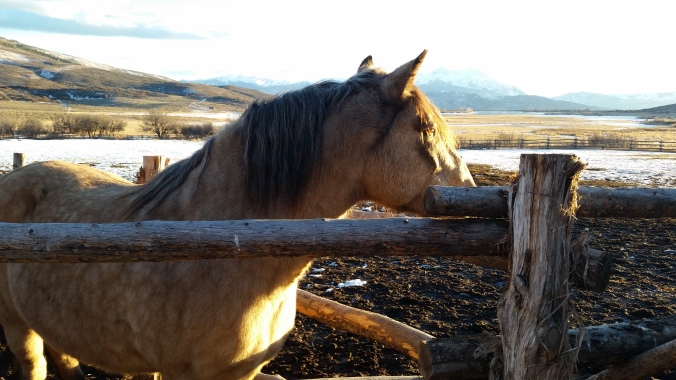
Everyone said he was lazy. He had a severely pulled back muscle, insulin resistance and early stages of cushings.
If you’d like to know more about how to assess and address any issues your horse may be having check out my facebook group: The Tango with Horses Tribe, and look for upcoming trainings for horse owners to assess their own animals.
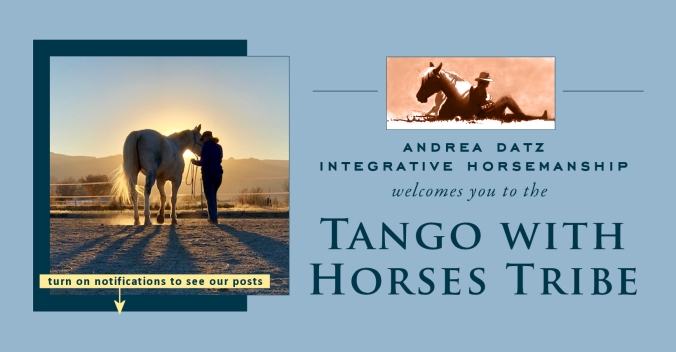


Such an important message Andrea. Thank you.
What I am wondering, having a horse or three who I want to make sure I am doing right by, is when we are not sure what the problem is, where do we turn? You mention adhesions here. How would one suspect that and then find it? I’m not sure I have an osteopath nearby. How would I find one?
I think that many people just don’t know where to go with their concerns, or even what kinds of problems are possible. For example, several years ago, when my horse was all around combative and reared when ridden, I didn’t even know that kissing spine existed. Ultimately, that’s what he had, along with some other things probably and who knows which came first. Ulcers causing kissing spine or vice versa?
And now I have a horse who I have been concerned about for 7 years but there’s nothing overt. He just checks out when taken out to do anything with him and is very quiet and unwilling to go forward. I feel like I have tried so many things and don’t know where to go next. But the last thing I will do is push him out of fear he is not well or that I am causing more pain/harm.
Anyway, any help you can offer in learning to listen, observe, and get help would be much appreciated!
LikeLiked by 1 person
Hi Kim, honestly, the best solution I’ve found for my clients is that they learn to evaluate their own horses. I’ve started a new group on FB that you can link to at the end of the blog. I plan to offer a series of short e-courses designed to teach average people to palpate and uncover/work with underlying issues. If you want some ongoing support you might hop over to the group page where I share more than just my blog.. It can be really challenging to find the help you need, or even to know who to call. If you have a skill set that allows you to do your own assessment it can at least help you narrow down what kind of expertise you need to seek out.
LikeLiked by 1 person
This post could not be more timely for me. My mustang, Hummer, just tested positive for an autoimmune/neurological disease called Polyneuritis Equi, which causes him to have intermittent, sudden and drastic reactions both under saddle and on the ground. He acts like he is getting shocked with a cattle prod. The worst instance was when he was walking along under saddle, just warming up at the beginning of the ride, having been a perfect gentleman all spring and summer, and that day, he went from walking relaxed on a loose rein to sudden and very hard bucking that was so bad that he threw my friend, who is a strong rider. He had never done anything like that before. Then a week or so later, I was putting his halter on, and as I went to do up the buckle, he jumped backwards like I had shocked him with a cattle prod. This happened twice within a few minutes. There have been other, very subtle signs…like an occasional little “tuck” of his hind end when I brushed a soft brush over his loins (but no reaction to palpation with my hands), and occasional “crabby ears” when asked to go forward, and an overall increase in jumpy/spookiness in response to the environment.
I can’t tell you how many people told me this was a behavioral issue, that I needed to do this or that in his training, that he was just being “bad” and trying to get out of work, etc.. I know my horse really well, and none of that made any sense at all. So then the medical investigation started. Chiropractic exam. Lameness exam. Scoped for ulcers. X-rayed his entire neck and spine. Nothing. This of course reinforced the litany of “it’s behavioral” from left right and center. I still didn’t buy that.
Then I posted about my horse on a Facebook group called Horse Vet Corner. None of the vets had any ideas for me — just more of the “it’s behavioral” stuff. Fortunately, a lady who is not a vet saw my post and contacted me, telling me that what I described reminded her of what happened with her own horse, who turned out to have PE. She told me about the lab that does the test for it (which none of my vets even knew existed), and after talking with the head researcher there, I decided to send in a blood sample for testing. I got the results today, and while I am of course not happy to learn that my horse has a serious neurological disease that will progress to hind-end paralysis if left untreated, the good news is that there is a treatment that is usually successful, and it is not even expensive. I don’t yet have all the information about what exactly is entailed and what the ultimate prognosis will be, but I am hopeful.
I also feel vindicated to have trusted my gut and believed in what I felt my horse was telling me. I truly agree with you, Andrea — there is no such thing as “bad” behavior. When a horse does something we don’t want them to do, they are either in pain, or they are confused and/or worried about what we are asking from them. Sometimes they are all of those things. Please, people — share Andrea’s post. The more we can get these thoughts out to the horse community, the better.
Thank you, Andrea.
Susan Kauffmann, lead author, The Essential Hoof Book
LikeLiked by 1 person
Wow Susan!
That’s intense. I’m so glad Hummer had you in his corner. Thank you for sharing your story. This is a perfect example of what I’m talking about. Sending lots of good wishes for a speedy and full recovery!
LikeLike
So much Value in what you proffer ! however there are such things as poor behavior, mostly, learned from people but not always like some of us there are those that have a proclivity for it and sometimes when those tendencies are remedied go on to make reliable mounts and even outstanding Horses…
LikeLiked by 1 person
Hi Boyd, I do agree horses can learn undesirable habits from humans. I remember one who had learned to bump into people and I do see it all the time, where people inadvertently teach horses something that they then blame on the horse’s ‘bad’ behavior and proceed to try and fix through training. I still maintain there’s no such thing as ‘bad’ behavior. Behaviors are simply the horse’s way to communicate with us about what’s going on with them – that can include how they feel as well as showing us what they are learning. I find with those horses that have human learned behaviors we might define as poor, it’s pretty easy for them to learn a different approach. If they struggle to learn a different approach I’d still look for pain or an underlying health issue. And I’m always going to rule out pain before I proceed to train. Thank you for chiming in, I appreciate your perspective.
LikeLiked by 1 person
Hello Boyd. There are certainly many kinds of behaviors that horses can exhibit that are undesirable or dangerous to us. However, as Andrea says, horses are not trying to be “bad”. They are always simply doing what they believe they need to do in the moment based on what they have learned and what they feel. Mostly, they just want to get along and get by without stress. Are there horses that are naturally more likely to get defensive or interact more spatially than others? Certainly. Horses are all individuals and there is a vast amount of variation in their temperaments and personalities, not to mention their life experience. But I wouldn’t say that makes their behavior “poor”. It just means that you have to know how to help the horse find the way that works for you both, so that they can, as you say, become reliable and even outstanding horses. That said, Andrea’s very important point is that far too often, the undesirable behaviors horses exhibit are rooted in pain and discomfort, and we need to try much, much harder to take that into consideration. I have been a professional in the horse industry for over 30 years, and the number of cases I have seen where a horse was “misbehaving” and it turned out to be due to pain is heartbreakingly high. This is especially true for a horse that has been going well and then starts “acting up for no reason”. There is ALWAYS a reason, and it is our job and our responsibility to find it!
LikeLiked by 1 person
Thank you for sharing your perspective as well Susan. I’m to a point where I just don’t label behaviors as good, bad, poor, or otherwise. Behaviors are there for a reason and it’s up to us to figure out why. It sounds like you are on the same page as I am in that regard. I think it’s in the labeling of the behavior as bad that things can go sideways for the horses and our motivation in dealing with the problem.
LikeLike
We are absolutely on the same page, Andrea. I was just saying to someone today that if a horse does something we would rather he didn’t, it is on us, 100% of the time, to figure out why and help the horse get to a place where he no longer feels the need to do that. Whether it is a matter of teaching the horse something or figuring out a pain/discomfort issue, the solution is always our responsibility, as the horse is just doing what he believes and feels he needs to do at that moment. I never get mad at a horse — ever — and I never punish them or feel that I need to dominate them and gain their “respect”. This doesn’t mean I allow dangerous behaviors by any means, nor do you I am sure, but I have found that if we can meet the horse’s true needs, both mentally and physically, such behaviors simply go away because the horse understands and feels okay with what we are asking. Assuming, of course, that there isn’t a pain issue!
LikeLiked by 1 person
That’s been my experience as well Susan.
LikeLike
Hi Andrea – I just read your post. Thank you. You are reinforcing all that I began to learn from you some years back. There are the awkward moments when I challenge the conventional wisdom of trainer and veterinarian but we continue toward together in a harmonious way – to the benefit of the horses. The more I “listen” the more they tell me. Even stoic Henry 🙂
LikeLiked by 1 person
Hi Martha, I’m glad you are finding YOUR way.
LikeLike